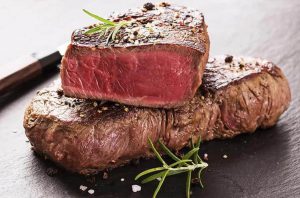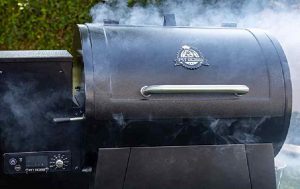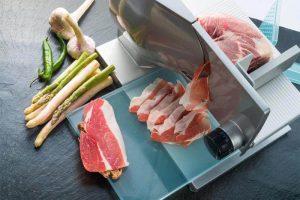Ready to elevate your steak game with the perfect griddle-cooked experience?
In this guide, we’ll explore essential tips for preparing, cooking, and determining the doneness of your steak.
From choosing the right cut to mastering cooking techniques, we’ve got you covered with our expert advice for a delicious and satisfying meal.
- How Can You Properly Prepare A Steak For Cooking On A Griddle?
- Type Of Steaks For A Griddle
- Key Factors For Choosing The Right Steak Cut
- How Do I Know My Steak is Cooked?
- Steak Cooking Temperature Table
- Video: The Perfect Steak on a Griddle
How can you properly prepare a steak for cooking on a griddle?
Cooking steak on a griddle can yield exceptional results if you properly prepare the meat beforehand.
Here’s a comprehensive guide to getting your steak ready for the perfect griddle-cooked experience:
1. Bring the Steak to Room Temperature:
To enhance the browning and searing process, take your steak out of the refrigerator and let it sit at room temperature for about 30-45 minutes before cooking. This will help the meat cook more evenly and ensure a better crust formation.
2. Pat the Meat Dry:
Make sure your steak is as dry as possible before it hits the griddle. Use a few layers of paper towels to blot the meat on both sides, removing any excess moisture.
This step is crucial for achieving a beautiful, caramelized crust, as wet meat will steam before it starts to brown.
3. Season with Simplicity:
While there are many delicious beef seasonings available, sometimes less is more. Opt for a good-quality kosher salt to enhance the natural beef flavor and assist in tenderizing the meat.
Use about half a teaspoon of kosher salt per side, seasoning when you take the steak out to reach room temperature.
4. Add Optional Flavors:
If you’re looking for additional flavors, brush the steak lightly with olive oil and sprinkle it with a touch of freshly ground black pepper.
You can also experiment with other spices like paprika, chili powder, or garlic powder.
5. Trim Excess Fat:
To maintain flavor without sacrificing texture, trim the fat around your steak to a thickness of about 1/4 inch or remove it altogether. This will ensure a balanced taste and prevent excessive grease on the griddle.
Once your steak is prepared following these steps, preheat your griddle to the desired temperature (usually around 300°F) and cook each side for about 3 minutes, flipping until you achieve your preferred level of doneness.
Let the steak rest for 5-10 minutes before enjoying, allowing the juices to redistribute and the residual heat to continue cooking the meat.
Related >> 11 Best Flat Top Grills and Griddles
Type of Steaks for a Griddle
Choosing the right type of steak to cook on a griddle is essential for the best results. Your choice may depend on personal preference, budget, or occasion.
Here are our top recommendations for steaks that perform well on a griddle:
Boneless Ribeye:
A popular and flavorful cut, the boneless ribeye boasts a rich beef taste. When choosing a ribeye, look for one with a large ribeye cap or spinalis dorsi, which many consider being the most flavorful part of the steak.
Sirloin Steak:
An affordable yet tasty option, sirloin steaks are leaner than ribeyes but still pack plenty of flavors. With a bit of chewiness and tenderness, sirloin steaks offer a fantastic combination of taste and value.
Filet Mignon:
Known for its unmatched tenderness, filet mignon may not be as rich in flavor as ribeye or sirloin, but it more than compensates with its buttery texture. This cut is perfect for those who prioritize tenderness above all else.
New York Strip Steak:
A bold and beefy cut, the New York Strip has a chewiness similar to sirloin and a desirable fat cap that renders beautifully when cooked. Though it can be pricey, keep an eye out for sales to treat yourself to this fantastic griddle-cooked steak option.
Wagyu Manhattan Filet:
For a truly indulgent experience, try an American Wagyu filet. This luxurious cut is often regarded as the best steak for beef enthusiasts and promises an unforgettable meal.
Reverse-Seared T-Bone:
Combining the best of several steak worlds, the T-bone is an excellent choice for griddle cooking. The reverse-sear technique ensures a perfectly cooked T-bone, delivering the ultimate steak experience.
The ideal steak for griddle cooking depends on your preferences and budget.
Whether you opt for a boneless ribeye, sirloin, filet mignon, New York Strip, Wagyu Manhattan filet, or reverse-seared T-bone, you’ll be sure to enjoy a delicious and satisfying steak dinner.
Related >> 11 Types of Ribs
Key Factors for Choosing the Right Steak Cut
Selecting the right steak for griddle cooking can make all the difference in taste and texture.
Here are some key factors to consider when picking out your steak:
Deep Red Color:
Look for a steak that has a rich, deep red hue. This indicates freshness and good quality.
Moisture Level:
Your steak should appear moist but not overly wet. A well-balanced moisture level is essential for a delicious and tender result.
Smooth Edges:
The edges of the steak should be even and free from any ragged or torn parts. This ensures uniform cooking and a visually appealing finished product.
Marbling:
Opt for a steak with medium marbling, characterized by fine streaks of fat running through the meat. When using a griddle, these streaks will melt as the steak cooks, naturally basting it from within and enhancing its flavor.
Minimal Connective Tissue:
A great steak should have minimal connective tissue, as it can make the meat chewy and tough. By choosing a cut with less connective tissue, you’ll enjoy a more tender and satisfying griddle-cooked steak.
How Do I Know My Steak is Cooked?
Knowing when your steak is cooked to your desired level of doneness is essential for a perfect grilling experience.
Here’s a guide on how to tell if your steak is ready:
Use a Meat Thermometer:
The most reliable way to check your steak’s doneness is by using a meat thermometer or an instant-read thermometer.
Insert the thermometer through the side of the steak, ensuring the tip is in the center without touching any bone or fat.
Keep in mind that the temperature will continue to rise as the steak rests for 5-10 minutes after cooking, so remove it from heat when it reaches 5°F lower than your desired doneness.
Assess the Meat’s Color:
While color alone isn’t a perfect indicator, it can provide a helpful reference.
Rare steak will have a red center, medium rare will be pink, and medium will be brown throughout. Well done steak will be dark brown or black.
Test with a Finger Press:
Another way to check steak doneness is by pressing on the meat with your finger.
Rare steak will feel soft, medium-rare will be slightly firm, and medium will be firm. Well done steak will feel hard.
This method may be less accurate than using a thermometer, but with practice, you can achieve consistent results.
Steak Cooking Temperature Table:
| Doneness | Temperature | Description |
|---|---|---|
| Rare | 125°F | Cool red center |
| Medium Rare | 135°F | Warm red center |
| Medium | 145°F | Warm pink center |
| Medium Well | 150°F | Slightly pink center |
| Well Done | 160°F | Little or no pink center |
Note: The USDA recommends cooking steaks to a minimum internal temperature of 145°F (medium) and resting them for at least 3 minutes before serving.
You can also watch a video about “The Perfect Steak on a Griddle with Chef Nate” below:
Related >> How Long to Smoke a Brisket Per Pound (Timelines Chart)
Final Thoughts
Armed with these tips and temperature guidelines, you’ll be well on your way to griddle-cooking a mouthwatering steak to your preferred level of doneness.
Remember to select the right cut, prepare your steak properly, and monitor its internal temperature for the best results.
With a little practice, you’ll soon become a master of griddle-cooked steaks, impressing friends and family with your culinary skills.
Enjoy your delicious, juicy steak, and happy grilling!
>> Visit our extensive BBQ guides page for more articles that are similar to this one.
Greetings! I’m Chad, a 43-year-old barbecue aficionado hailing from the beautiful state of Texas. I’m thrilled to invite you on a culinary journey as we explore the art of grilling and smoking together. Through this blog, I aim to ignite your passion for barbecue by offering:
Scrumptious, time-honored BBQ recipes passed down through generations, guaranteed to tantalize your taste buds.
Expert guidance on mastering the grill, smoker, and diverse cooking techniques to elevate your barbecue game.
Recommendations on choosing the perfect tools and equipment tailored to your grilling requirements.
An inside look at the latest trends, innovations, and advancements in the ever-evolving world of barbecue.





